June 10th 2025
Championing Environmental Sustainability – What Set the Walsh Family Apart
1. Efficiency and Profitability
Sustainability relies on balancing economic, environmental, and social factors. The Walsh’s have achieved this balance by running a highly efficient and profitable dairy operation.
They milk 165 cows on a 63ha platform, with a total grassland area of 107ha. Their strong breeding policy, emphasizing the Economic Breeding Index (EBI) and sexed semen, supports herd productivity and sustainability. Once replacement heifers are secured, they use high Dairy Beef Index sires to boost animal value.
In 2024, they produced 524kg of milk solids per cow with 1250 kg of concentrate per cow, achieving a gross margin of 60.2c/L and a carbon footprint of 0.81kg CO2eq/kg FPCM—well below average. Total emissions on the farm stood at 1,039 tonnes CO2eq.
2. Reduced Chemical Nitrogen Usage
The Walsh’s have reduced chemical nitrogen (N) usage by 40% since 2020, without compromising grass production. In 2024, they used 130kg N/ha (down from 220kg in 2020) while producing 13.7 tonnes of grass DM/ha. Nitrogen use efficiency on the farm was 29%.
Their success stems from optimised soil fertility (64% of soils are at optimal levels for pH, phosphorus, and potassium), widespread clover incorporation (52% of the grazing platform has a high or medium clover content), targeted slurry use based on testing and extensive use of protected urea (100% in 2024).
With 15% surplus slurry storage and precise application methods, they reduce the risk of nitrogen runoff and protect water quality through extensive buffer zones and GPS-guided spreading.
3. Commitment to Biodiversity
Biodiversity is a long-standing priority on the Walsh farm, dating back generations.Hedges are managed to promote growth and diversity, with whitethorns allowed to flourish every 50m.
Groves of trees, including a 3ha forest transitioning from spruce to native species, are scattered across the farm. They plant trees annually, and the presence of barn owls, herons, and even a curlew reflects the thriving biodiversity.
Key Takeaways
The Walsh family exemplifies a well-planned, balanced approach to sustainable dairy farming. Their message to other farmers is: start small, seek good advice, and don’t fear failure. Their success story is not just about awards, but about building a resilient and environmentally responsible future for Irish farming.
Event Boards
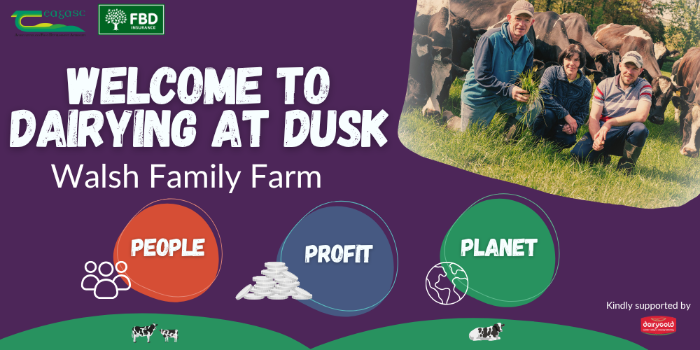
This introductory board welcomes visitors to “Dairying at Dusk” at the Walsh Family Farm. It sets the stage for the tour, highlighting key themes of people, profit, and planet.
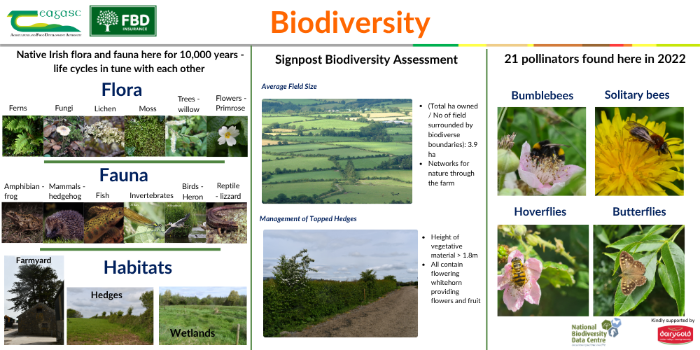
This board highlights the Walsh Farm’s commitment to biodiversity, showcasing native Irish flora and fauna. It provides an insight into the results of a Signpost biodiversity assessment explaining the average field size of 3.9 ha and how their topped hedges all contain flowering whitehorn providing flowers and fruit. It also reveals 21 pollinators were found on the farm in 2022 including bumbles, solitary bees, butterflies and many more.
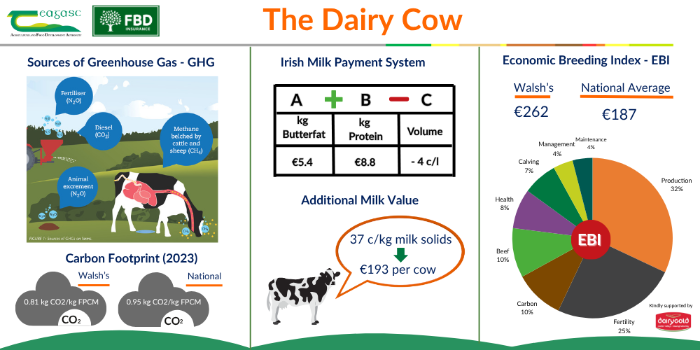
The main sources of greenhouse gas emissions are shown for dairy cows including methane, diesel, fertiliser, animal excrement. Walsh’s farm has a lower-than-average carbon footprint (0.81 kg CO₂/kg FPCM vs. the national 0.95), a higher-than-average Economic Breeding Index (€262 vs. €187), and benefits from an additional milk value of €193 per cow due to milk composition. These factors reflect a well-managed, environmentally efficient, and economically productive dairy operation.
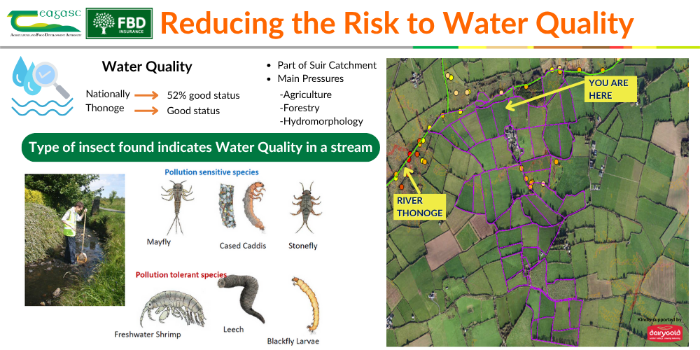
The board explains the importance of water quality, noting that 52% of Ireland’s water bodies have good status, including the River Thonoge in the Suir catchment. It shows that agricultural, forestry, and hydromorphological pressures affect water quality. Water quality in streams can be assessed by the types of insects found, with pollution-sensitive species like mayflies and pollution tolerant species like leech being showcased. A map pinpoints the farm’s location relative to the river and surrounding landscape.
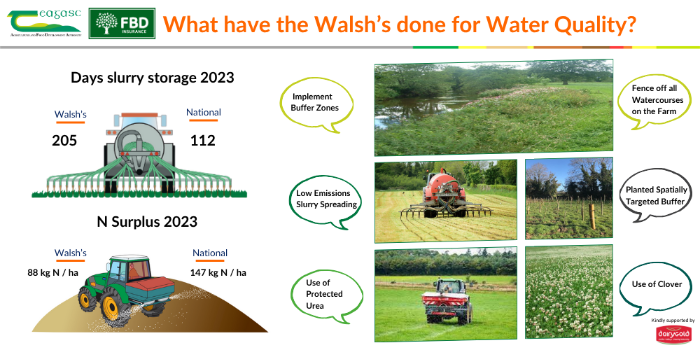
This slide outlines measures the Walsh family farm has taken to protect water quality, outperforming national averages in slurry storage (205 vs. 112 days) and having a lower nitrogen surplus (88 vs. 147 kg/ha). Actions include implementing buffer zones, fencing watercourses, planting targeted buffers, and using low-emissions slurry spreading. The farm also relies on protected urea and clover is used to further reduce reliance on chemical N.
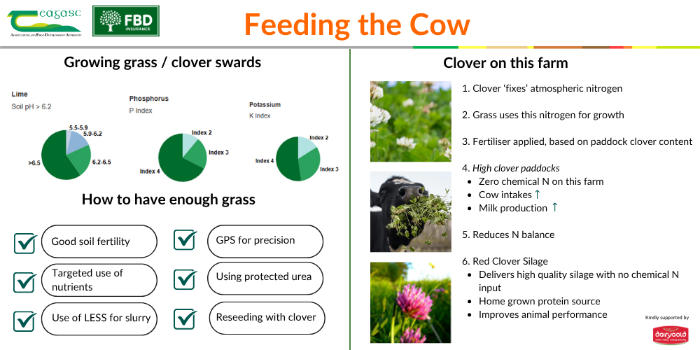
This board focuses on how to grow grass and clover swards effectively to feed livestock. It highlights the importance of good soil fertility, targeted nutrient use, and methods like reseeding with clover and using protected urea. Clover is promoted for its ability to fix nitrogen, reduce fertiliser needs, and improve cow intake and milk production. Red clover silage also improves animal performance without chemical nitrogen input.
